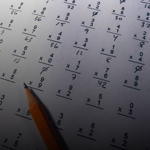Preview this deck
Inclusion-exclusion identity
Front
Active users
8
All-time users
11
Favorites
0
Last updated
5 years ago
Date created
Sep 14, 2020
Cards (6)
Chapter 2
(1 card)
Inclusion-exclusion identity
$$\begin{aligned}P\left(\bigcup_{i=1}^n A_i\right) &= \sum_{i=1}^n P(A_i) - \underset{i<j}{\sum\sum} P(A_iA_j)\\&+ \underset{i<j<k}{\sum\sum\sum} P(A_iA_jA_k)\\&- \ldots + (-1)^{n+1}P(A_1\cdots A_n)\end{aligned}$$
Chapter 3
(1 card)
Gambler's ruin problem
Probability of winning is
\[P_i = \begin{cases}\frac{1 - (q/p)^i}{1 - (q/p)^N} & \text{if } p \neq \frac12\\\frac{i}{N} & \text{if } p = \frac12\end{cases}\]
when starting with \(i\) out of \(N\) units and winning each round with probability \(p\) (\(q = 1 - p\)).
Chapter 4
(4 cards)
Expected value and variance of a Binomial random variable
$$\begin{aligned}\mu &= n \cdot p\\\sigma^2 &= n \cdot p \cdot (1 - p)\end{aligned}$$
$$i \cdot {n \choose i}$$
$$n \cdot {n - 1 \choose i - 1}$$
Expected value and variance of a Poisson random variable
$$\begin{aligned}\mu &= \lambda\\\sigma^2 &= \lambda\end{aligned}$$
Poisson paradigm (aka law of rare events)
If \(n\) is large and \(P(\text{event})\) is small, the number of events is approximately modeled by the Poisson distribution where \(\lambda = \sum_{j=1}^n p_j\).


